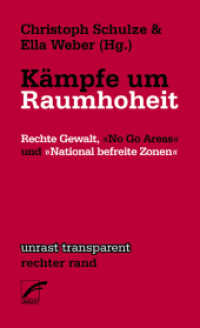- ホーム
- > 洋書
- > ドイツ書
- > Mathematics, Sciences & Technology
- > Earth Science
Full Description
This book introduces a model for the built environment, designed to incorporate sustainability at every level. It emphasizes the integration of environmental, social, and economic factors to create resilient urban spaces. Also, it presents a decision support system that optimizes energy management for sustainability, enabling real-time adjustments and reducing carbon footprints. It discusses innovative strategies for managing water and wastewater in swampland areas, offering insights from UIN Raden Fatah Palembang's adaptation efforts.
Also, this book provides a thorough review of bio-based business models, examining their agility and adaptability in fostering sustainable innovations that respond to market and environmental changes. Moreover, the book explores a novel approach to renewable energy, this chapter assesses the feasibility of using vortex bladeless wind turbines for energy generation at airport runways, offering both conceptual and economic analyses. In addition to discuss the creation and role of multi-actor forums in promoting a sustainable blue economy in the Black Sea region, emphasizing collaborative efforts to preserve marine resources.
This book investigates the use of halophyte biochar as a sustainable soil amendment for sandy soils, demonstrating its potential to improve soil quality and promote sustainable agriculture. Also, the book aims to assess the sustainability of food-energy-water systems at the household level, advocating for integrated solutions that enhance resource efficiency and sustainability. This book delves into societal perceptions of climate change adaptation, using interaction analysis to better understand public attitudes and their implications for policy and communication strategies. This book presents a case study from Istanbul, offering insights into how local identity can strengthen community resilience and sustainability efforts. Finally the book provides a comprehensive guide to understanding and implementing sustainable practices across various sectors, from energy management and water resources to food systems and environmental education. It emphasizes the importance of interdisciplinary approaches and innovation agility in addressing global sustainability challenges.
Contents
.Part 1: Bio-Based Business Models for Sustainability: Water and Climate Action.- 1. An Integrated Model of and for the Built Environment.- 2. An Intelligent Decision Support System for Sustainable Energy Management.- 3. Implementation of SDGs on Water Resources and Climate Action: Sustainable Water and Wastewater Management Based on Swampland Adaptation at UIN Raden Fatah Palembang.- 4. Examining Innovation Agility: A Review of the Bio-Based Business Models.- 5. Vortex Bladeless Wind Turbines for Airport Runway Energy Generation: Conceptual and Economic Feasibility Studies.- 6. Black Sea blue transitions: Multi-Actor Forums to promote a sustainable blue economy.- Part 2: Multi-Disciplinary Approach: From Soil Amendments to Food Systems.- 7. Assessment of Halophyte Biochar for the Amendment of Sandy Soil.- 8. Scope of a Millet-Based Food System in Reducing Metabolic Syndrome and Carbon Footprint in the UAE: A Policy Perspective.- 9. Towards a Holistic Assessment Framework for Sustainable Household-Level Food-Energy-Water Systems.- Part 3: A Comprehensive Approach to Environmental Solutions.- 10. Social perception of Climate Change Adaptation: interaction analysis.- 11. Relationship Between Social Sustainability and Place Attachment: The Case Study of Istanbul, Turkey.- 12. Integrating Impact Indicators for Environmental Education in the Planning and Management of Protected Areas.- 13. Beyond Western Criticism: The benefits of the UAE's political neutrality and public diplomacy to facilitate dialogue at COP28.- 14. Collaborative Planning of AI chatbots in Online Health Communities: sociomateriality and sustainability perspectives.- 15. Sustaining Innovation Performance in Service Organizations: The Role of Total Quality Management Practices and Strategic Alignment.








